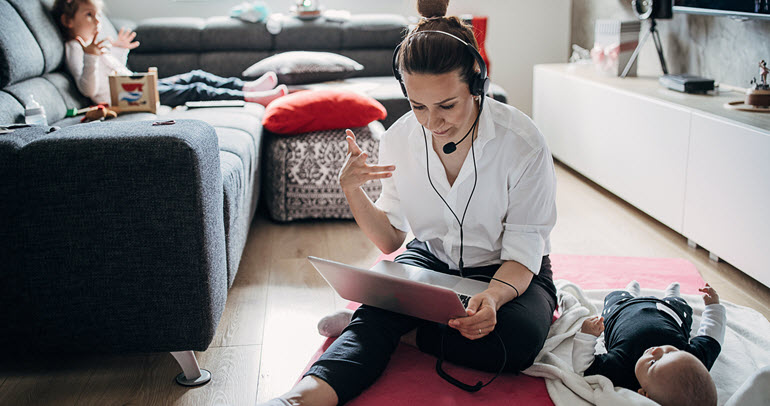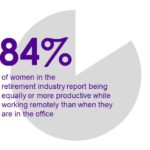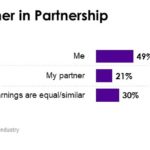
Balancing a fulfilling career with a fulfilling life, whatever that means for a given individual, has become the new American dream. Employers have an obligation to ensure both men and women employees have equal opportunities to climb the corporate ladder by helping them find that balance between familial and household management and their careers.
Modern technology and the ability to never truly be cut off from the workplace have made achieving a healthy work-life balance an issue for many. But that balance is imperative to one’s success. Last fall, WIPN and Escalent embarked on a first-of-its-kind assessment of the attitudes, experiences, behaviors and compensation of women in the retirement industry. Through the research it became clear we’ve made some advancements toward balance as remote work becomes more prevalent. When it comes to employers, however, improvements are still necessary. To ensure their employees succeed in managing work-life balance, specifically among those who are also responsible for caregiving and household management, employers need to embrace flexibility. They must encourage and support their employees living full lives outside of work.
Balance is Imperative to Success
Work-life balance is a clear goal for women in high-profile careers, with one in three women in the retirement industry indicating it’s their top sign of success. Despite the clear importance, only 56% of the women we surveyed are satisfied with their current work-life balance, signaling that this highly important goal is seemingly difficult to achieve.
It begs the question, what does true work-life balance look like? The answer is different for everyone. For one woman, it could look like achieving a high level of success at work and raising children. For another, it could look like attaining a high level of success in the workplace and having hobbies in the evenings. Interestingly, we find no meaningful difference in satisfaction with work-life balance by age. Difficulty achieving this balance exists for every generation, suggesting that it’s not just an issue for caregivers.
 It appears that for some, the current crisis may have had a small upside, as the ability to work remotely has positively affected the achievement of work-life balance among women in the retirement industry. Over two-thirds (69%) of the women we surveyed have stated that a better work-life balance is one of the top benefits to working remotely. With over eight in ten women indicating they are just as productive working remotely as in the office, it appears a healthy work-life balance is easier with a reduction in commuting and increased flexibility. When working remotely, taking a 5 pm class during the workweek or taking your children to the park becomes achievable. In fact, 85% of women state they do find some time for activities that support their well-being while working remotely.
It appears that for some, the current crisis may have had a small upside, as the ability to work remotely has positively affected the achievement of work-life balance among women in the retirement industry. Over two-thirds (69%) of the women we surveyed have stated that a better work-life balance is one of the top benefits to working remotely. With over eight in ten women indicating they are just as productive working remotely as in the office, it appears a healthy work-life balance is easier with a reduction in commuting and increased flexibility. When working remotely, taking a 5 pm class during the workweek or taking your children to the park becomes achievable. In fact, 85% of women state they do find some time for activities that support their well-being while working remotely.
Caregiving and Work-Life Balance
Though women continue to make huge strides in a workforce once dominated by men, when it comes to caregiving, there is still discrepancy in households. Women caregivers in our survey reported spending one-third more time (approximately five hours) than their partners on caregiving and household management. The burden of these family tasks appears to lay heavily with women despite their career success, as 49% of women caregivers indicate they are the primary earners in their household and 30% indicate earning equal pay to their partner.

Despite efforts to strive for equality among men and women caregivers in terms of career opportunities, employers still tend to show a reluctance to allow women caregivers the same levels of advancement. As can be seen in the quotes shared below, two women indicate their willingness to accept a lower salary or avoid a promotion for the sake of work-life balance.
“I am underpaid but I choose to be because my current role/company allows for complete flexibility when it comes to dealing with family—my children are under two years old.” – Millennial
This is where employers can do better to support women employees by creating a flexible work environment. Not offering flexibility severely limits their ability to achieve a healthy work-life balance, and in turn holds women to higher standards when it comes to caregiving and household management.
“Having been out on three maternity leaves in the last five years has been a very clear detractor to my promotion schedule. In fact, I missed a promotion last year with the comment, ‘you will not be able to get enough face time before the end of [the] year’ [baby was due early September].” – Millennial
What’s Next?
Ideally, a post-COVID-19 world is what is next! Employers have a say in what that looks like for their workforce. The flexibility of remote work is significant for the achievement of a healthy work-life balance, and employers can continue to provide that flexibility and promote the well-being of their employees after the pandemic is over. The world of caregiving can also stand to see some change in a post-COVID-19 world with that same level flexibility. In particular, 49% of women indicating themselves as the primary earners and 30% indicating earning equal pay to their partner are clear indicators that times have changed in the workforce and terms need to change in caregiving and household management. Women have entered the workforce, and it is time for men in these partnerships to increase participation in caregiving and household management. Employers have a responsibility to not see a working mother as an opportunity for a discount, and instead encourage equal standards among men and women when it comes to being caregivers and managing households.
For a deeper look at the attitudes and behaviors of women in the retirement industry, download our joint white paper with WIPN, What’s Working at Work.








